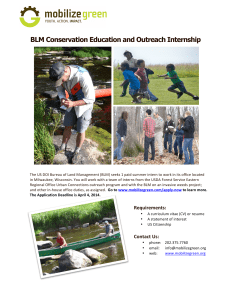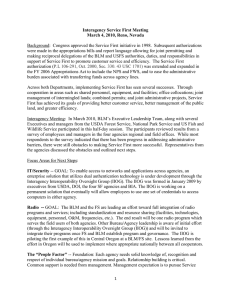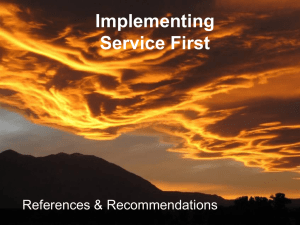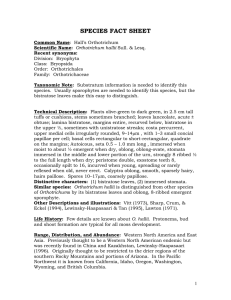BLM CLIMATE CHANGE ACTIVITIES CESU ANNUAL MEETING PORTLAND, OREGON
advertisement
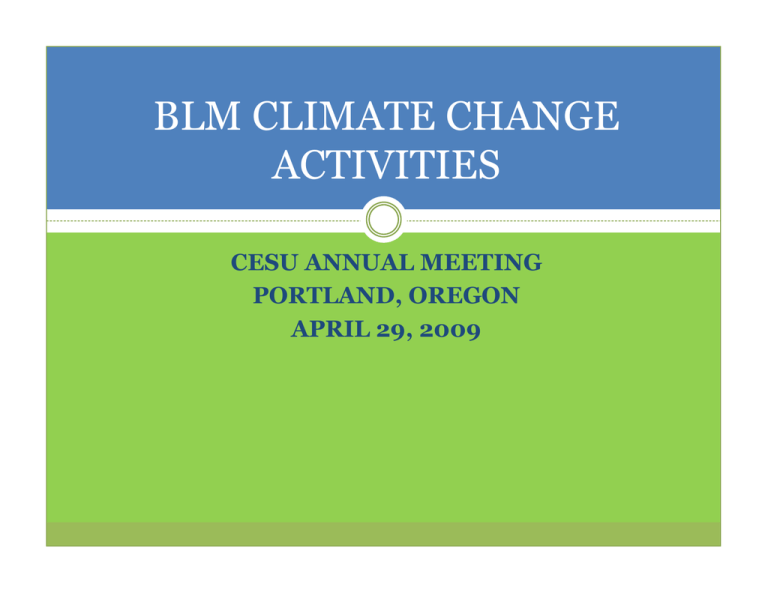
BLM CLIMATE CHANGE
ACTIVITIES
CESU ANNUAL MEETING
PORTLAND, OREGON
APRIL 29, 2009
THE BASIS FOR DOI AND BLM
CLIMATE CHANGE ACTIVITES
y
FY 2009 and 2010 Appropriation Acts and Conference Reports
y
E.O. 13514 on Federal Leadership in Environmental, Energy,
and Economic Performance (October 5, 2009)
y
CEQ’s Draft Framework for Coordination of Federal Land
Management Agencies to Address Climate Change
y
CEQ’s Draft NEPA Guidance on Consideration of the Effects of
Climate Change and Greenhouse Gas Emissions
y
President’s Memorandum on a Comprehensive Federal
Strategy on Carbon Capture and Storage (February 3, 2010)
y
Secretarial Order 3289 Addressing the Impacts of Climate
Change on America’s Water, Land, and Other Natural and
Cultural Resources (September 14, 2009)
y
DOI High Priority Performance Goals for FY 2010
In 2009, a climate change bill was passed
in the U.S. House of Representatives
(H.R. 2454); a similar bill was drafted in
the U.S. Senate. These are lengthy bills
addressing emissions reductions, carbon
capture and sequestration, nuclear and
other advanced technologies (including
natural gas and coal), water use
efficiency, recycling, renewable energy
including biofuels, green jobs, worker
transition assistance, and natural
resource conservation and adaptation.
Sections 341-384 of the Senate draft
include 90 pages addressing “Domestic
Adaptation.” If enacted into law, these
sections (and similar sections in the
House bill) would require much of the
regional assessment, collaborative
planning, science development and
integration, and other adaptation-related
work that is already underway within the
BLM, DOI, CEQ, and other agencies.
SUMMARY OF DOI DIRECTIVES
y Analyze potential climate change impacts when
undertaking long-range planning exercises, setting
priorities for scientific research and investigations,
developing multiyear management plans, and
making major decisions regarding potential use of
resources.
y Management responses to climate impacts must be
coordinated on a landscape-level basis.
SUMMARY OF DOI DIRECTIVES
y Quantify the amount of carbon stored in our lands,
identify areas where CO2 can be stored
underground, and develop carbon sequestration
methodologies for biological and geological carbon
storage.
y Promote environmentally responsible energy
development.
SUMMARY OF DOI DIRECTIVES
y Develop science-based adaptive management
strategies and tools to address the impacts of
climate change on our natural and cultural
resources.
DOI/BLM Climate Change
Strategy
TWO BASIC ELEMENTS
MITIGATION: ACTIONS TO MINIMIZE CLIMATE CHANGE
ADAPTATION: ACTIONS TO PREPARE FOR CLIMATE
CHANGE
MITIGATION
y Promoting renewable energy development
{ Solar, wind, geothermal, biomass
y Reducing our carbon footprint
{ Reducing agency GHG emissions
{ Reducing GHG emissions from authorized uses
y Carbon sequestration
{ Biological
{ Geological
ADAPTATION
y Obtaining down-scaled climate projections
{ NOAA Regional Climate Science offices
y Modeling regional impacts to resources and users
{ DOI Regional Climate Science Centers
y Determining and implementing responsive changes
{ Each agency, organization, private landowner – through
nested, landscape-scale collaborations including Landscape
Conservation Cooperatives (LCCs)
y Monitoring and adapting
{ CEQ is working with DOI, DOA, and DOD to foster a unified,
multi-scale monitoring approach
ECOREGIONAL ASSESSMENTS
y BLM will conduct a series of ecoregional assessments
beginning in FY 2010
y Driven in part by landscape-scale concerns about
impacts to resources from renewable energy siting
y Designed to help address other landscape-scale
concerns, including invasive species, altered fire
regimes, and climate change
ECOREGIONAL ASSESSMENTS
BLM – Rapid Ecoregional Assessment
y Rapid/No New Data Collection
y GIS Based
y Interdisciplinary and Collaborative – Multiple
Agencies and Stakeholders
y Define and Refine Management Questions
y Identify Goals and Objectives at Ecoregional Scale
Rapid Ecoregional Assessment
y Resource Values (status, risk and trend)
{ Native fish, wildlife and plants of conservation concern
{ Aquatic resource values
{ Terrestrial resource values
y Change Agents
{ Wildland Fire
{ Development (e.g., urban, industrial)
{ Invasive, non-native species
{ Climate Change
y Vulnerability Assessment
Rapid Ecoregional Assessments
y Proposed Process:
y Conduct rapid assessments
y Formulate eco-regional management strategies
y Conduct sub assessments as needed
y Develop conservation strategies
y Consider RMP Revisions/Amendments
y Implement conservation, restoration and adaptation
actions
y Carry out inventories, research, monitoring and
reporting
ECOREGIONAL STRATEGIES
y Assessments will lead to landscape-scale strategies
for conservation, restoration, renewable energy
siting, and other purposes
{
Northern Great Basin and Chihuahuan Desert are pilot areas
for developing ecoregional management goals, objectives, and
responsive actions
y Integrated, multi-agency, collaborative exercises
y Future landscape-scale strategies may be facilitated
by LCCs, developed and implemented through
nested collaborations
GREAT BASIN LCC
y BLM has initiated discussions to take the lead for the
Great Basin LCC.
y Initial meetings in Boise, Salt Lake City and Reno in
the next few weeks
Great Basin Landscape Conservation Cooperative
Organizational Concept
Climate Science Center
USGS
Great Basin Research &
Management Partnership
Integration of research & management
CSC
provides
science
for
applicati
on
Great Basin Cooperative
Ecosystem Studies Unit
Provides research, technical
assistance, & education
Great Basin Environmental
Program
LCC
provides
regional
science
needs
assessm
ent
GB LCC
Coordinate and
provide support to
ongoing and new
landscape scale efforts
to leverage resources
Utah Partners for
Conservation &
Development
Coordinate & implement restoration
projects
Nevada Partners for
Conservation &
Development
Coordinate & implement restoration
projects
Integrate efforts of governmental
agencies with NGOs & Private Sector
Eastern Nevada Landscape
Coalition
The Nature Conservancy
Sub –assessments & decision support
tools
Assess resources, implement &
monitor projects
Federal Agencies
Great Basin Native Plant
Selection & Increase Project
BLM, USFWS, USGS, FS, NRCS, BOR
Native plant development
Others
State Agencies
Oregon/Washington
Climate Change Strategy
Vision:
Minimize and mitigate the impact of climate
change on our resources and adapt our
actions accordingly
Climate Change Partnerships
Oregon/Washington BLM
Climate Science Center
USGS
State Agencies
Oregon/Washington BLM Climate
Change Strategy 2010 work
Science
Products
EMS
NEPA
Great Basin
LCC
2015 strategic
priorities
Partnerships
Ecosystem
Services
Employee
Awareness
Climate Change Strategy
Oregon/Washington BLM
•
EMS/SUSTAINABLE OPERATIONS
Green Procurement, Hazardous Materials Management.
Invasive Plant Management, Sustainable Operations Team
NEPA
• Provide NEPA guidance related to climate change,
specifically on: Affected environment, “significance”
• Quantification of climate change impacts associated
with BLM actions in NEPA documents
• Consideration of Programmatic EIS
Climate Change Strategy
Oregon/Washington BLM
Science Products
y
#1 Climate Change Synthesis- will have bi-annual updates
to remain relevant
y
#2 Downscaling- Consideration of a downscale model
that summarizes thousands of simulated models to provide
statistically valid answers to key questions
y
#3 GHG Model paradigm- Including partnership with
OWEB and Ecotrust for GHG related projects on the
Eastside
Climate Change Strategy
Oregon/Washington BLM
y
EMPLOYEE AWARENESS
FY10 Goals
{ Enhance climate change awareness within OR/WA BLM
{ Develop a common understanding, use common
terminology, increase employee awareness & education
{ Provide guidance to Program managers to better assist
the field with Climate Change information and analysis
relevant to their area of expertise
{ Ecosystem Services
BLM – Forest Service
BUSINESS NEEDS
ASSESSMENT
TERRESTRIAL PRIORITIES
y
Synthesize climate change outputs for vegetation – scale, new models
y
Fill gap for Klamath Basin downscaling
y
Develop bioclimatic envelopes for understory species, especially in
rangelands
y
Develop projections for changed fire regimes in all ecosystems
y
Simulate new habitat distributions
BUSINESS NEEDS ASSESSMENT
AQUATIC/WATERSHED PRIORITIES
Conduct a low flow risk assessments
Determine groundwater effects on stream hydrographs
Develop and apply stream temperature models for current
and future climates
Simulate new habitat distribution for aquatic species
Climate Change Issues
Defining the “Right” Management Questions
Baseline
Factors Influencing Groundwater
Data Accessibility
Decision Support Models
Integration Within and Across Agencies and Other Stakeholders
(Buy In)
THANK YOU
Karen Blakney
Research Liaison
Oregon/Washington BLM State Office
KBlakney@BLM.GOV
(503) 808-6509
